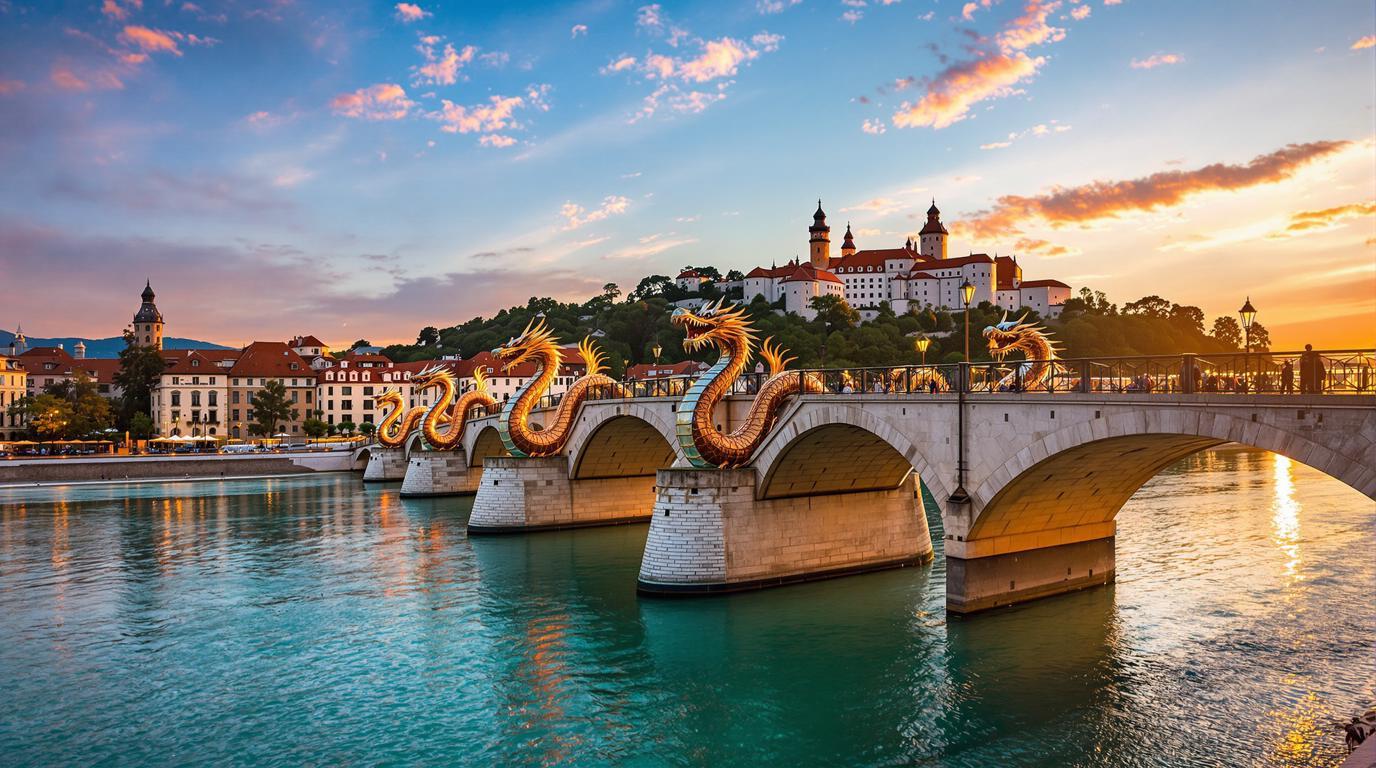Ljubljana’s emerald river weaves magic through Europe’s best-kept secret. While tourists crowd Prague and Vienna, Slovenia’s capital delivers all the Old World charm without the crowds—at prices 40% lower than neighboring capitals. The city center transforms completely between May and September, with riverside cafés extending over the Ljubljanica’s crystal waters while dragons stand sentinel from their iconic bridge perches.
Where dragons guard Europe’s greenest capital
Four copper dragons mark the corners of Ljubljana’s most photographed landmark, the aptly named Dragon Bridge. These fearsome guardians have become the unofficial symbol of the city, embodying a fascinating local legend that Jason (of Argonauts fame) slew a dragon here during his quest for the Golden Fleece. The mythical creatures now watch over a city consistently ranked among Europe’s greenest capitals, with pedestrian-only zones throughout its historic center.
A riverside promenade that rivals Paris (at half the price)
The emerald Ljubljanica River creates the beating heart of the city. Walking along its banks offers postcard-worthy views at every turn, with the Triple Bridge (Tromostovje) serving as the architectural centerpiece. This unique creation by beloved Slovenian architect Jože Plečnik connects the modern city with the medieval old town in spectacular fashion.
“Our river isn’t just a geographic feature—it’s our social lifeline. Where Parisians have their Seine, we have our Ljubljanica, but here you can actually hear yourself think,” explains Maja, a local café owner whose family has served coffee along these banks for three generations.
Slovenia’s castle-crowned skyline hides medieval secrets
Ljubljana Castle dominates the city skyline, perched dramatically atop a hill in the center. Dating to the 11th century, this medieval fortress houses museums, restaurants, and a virtual time machine that traces the city’s evolution. The 70-meter climb rewards visitors with breathtaking panoramas across red-tiled roofs to the Julian Alps beyond—best viewed during the golden hour when the setting sun paints the landscape in amber and rose.
A culinary scene that blends Balkan, Italian, and Austrian influences
Ljubljana’s food scene reflects its geographical crossroads. Sample kranjska klobasa (Carniolan sausage) alongside Italian-influenced risottos and Austrian-inspired pastries. The Open Kitchen (Odprta Kuhna) market transforms Pogačar Square into a foodie paradise every Friday from March through October, where local chefs cook everything from traditional Slovenian dishes to international street food.
For travelers who enjoy discovering hidden Alpine treasures, Bavaria’s pristine mountain lakes make an excellent companion destination to Ljubljana’s urban charm.
The magical summer months transform everyday spaces
Between May and September, Ljubljana truly comes alive. The city hosts dozens of festivals, from the Ljubljana Festival bringing world-class performing arts to open-air film screenings along the riverbanks. Street musicians provide the soundtrack as outdoor cafés spill across cobblestone squares, creating an atmosphere that rivals much larger European capitals.
“We Slovenians live outdoors during these months. The city becomes our collective living room,” says urban planner Jaka Prijatelj. “There’s something almost magical about how the barriers between public and private space dissolve.”
Getting there: 25km from an international airport yet worlds away
Ljubljana Jože Pučnik Airport (LJU) sits just 25km northwest of the city center, making this hidden gem surprisingly accessible. Regular flights connect through major European hubs, though many travelers combine Ljubljana with scenic train journeys across Europe that showcase the region’s spectacular landscapes.
The compact size makes Ljubljana ideal for walking exploration, though those seeking mountain adventures might consider venturing to more challenging trails elsewhere.
A perfect Mediterranean detour awaits nearby
While Ljubljana captures hearts with riverside charm, Slovenia’s compact size means the Mediterranean coast lies just 90 minutes away. After exploring the capital, many travelers continue to lesser-known coastal villages that rival more famous Mediterranean destinations at a fraction of the cost.
The French Riviera might have glamour, but Slovenia offers its own unique coastal experiences where Italian and Balkan influences create unforgettable flavors.
Ljubljana remains the rare European capital where authenticity still reigns. In a continent increasingly transformed by mass tourism, this emerald-kissed city offers a glimpse of what travel used to be—intimate, unhurried, and filled with genuine cultural exchanges rather than selfie opportunities. Visit between May and September to experience Ljubljana at its vibrant best, when dragons watch over a city that has mastered the art of living well.
